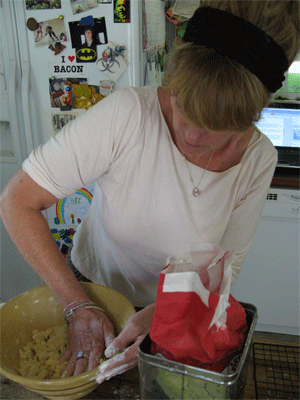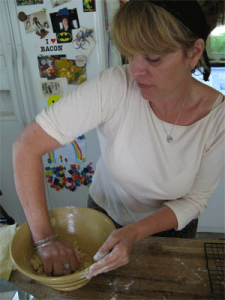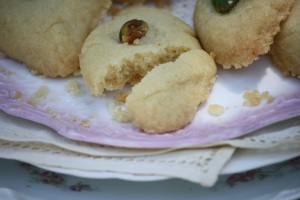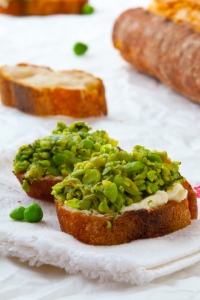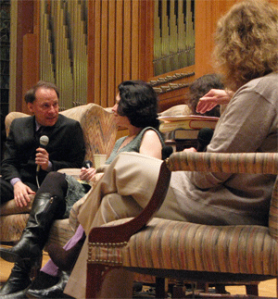We all know one of those extreme eaters, the friend who travels to exotic places and performs the gastronomic equivalent of running with the bulls. These people live for the goat’s eye, the snake’s heart, the putrefying cheese, the crispy insect. I’d like to be one of them, but it’s not gonna happen.
– Tom Perrotta, The Squeamish American
La Tartine Gourmande’s Béatrice Peltre revisits her childhood in the French countryside for memories and inspiration.
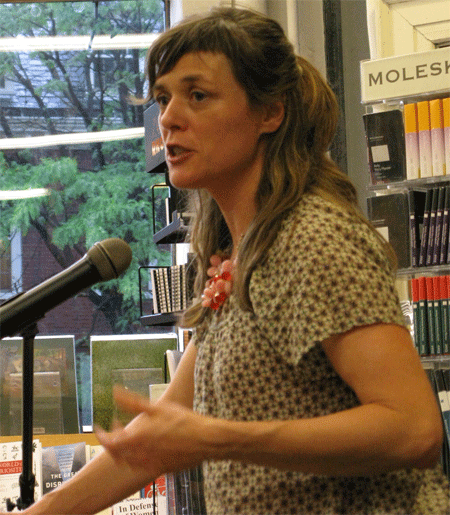 If you’re not yet familiar with Béatrice Peltre, you ought to be.
If you’re not yet familiar with Béatrice Peltre, you ought to be.
As one of the Boston area’s most successful food bloggers, Béa has built a showcase to her healthful and creative recipes, her food styling, her stories of growing up in the French countryside surrounded by a family in love with food and cooking, and her darling 3-year-old Lulu – half the age of the site itself, her first steps and first taste of les madeleines duly recorded and blogged.
It is the food styling and presentation that has led to the stunning photography that helps attract tens of thousands of fans to the site, La Tartine Gourmande. And now, Béa has published a book by the same name.
So why was I torn about whether to attend her appearance at Harvard Book Store Monday evening?

Peltre: An aesthetic approach to food
Well, I was skeptical, if not downright suspicious, of someone who appeared to make it all look so easy. Someone who reminded me a bit of Martha Stewart, who writes lovingly of her gardens and rustic homes as she pulls off her barn jacket for another wreath-making session, when you know full well her typical day is spent bossing around a huge staff, reading profit/loss statements, and griping about some deal about to go down the tubes.
Reviewers have gushed about Béa’s lovely home, her lovely food, her lovely accent, her lovely looks, lovely childhood…. you get the idea. It’s that haze of orchard-to-pie existence where nothing ever turns moldy in the fridge that leaves me A) wondering what’s wrong with my life, or B) wondering if it’s true indeed that practically any problem can be put right with a sprinkle of aged balsamic vinegar and a few grinds of fresh tellicherry pepper.
Add to that my impatience with “food personalities” who package and brand themselves; who care more for entertaining than educating. Sorry, but that’s my prejudice, and chefs/cooks like that make me cranky.
In Béa’s case, I was afraid she cared more about presenting a storybook than a cookbook. And the video trailer for the book, with its “gentle, plucky” soundtrack and images of her artfully arranging apple slices before sun-streaked windows and bouncing along meadows with husband Phil and Lulu in tow, did little to dispel my fears.

Styling the inspired life of Tartine Gourmande. (Photography by Béatrice Peltre)
I am happy to report that Béa did not live up to her advance billing. Her presentation at Harvard Book Store barely registered on the cranky meter. (And her video is actually a kick to watch.]
Aesthetics rule for her, and she is unapologetic about the role they play in her dishes and recipes. After all, she says, “You eat with your eyes first.”
“I need a set of colors and a set of ingredients I want to work with,” she says of her recipe development process. “I work around a pallet of colors and flavors. I think about shapes, like a painting. And I try to be original.”
Her early photos were terrible, she acknowledges. And she made the mistake of many food bloggers: trying to turn every meal and experience into a post, cramming as much as possible into her site.
But she taught herself photography and food styling, upgraded her camera equipment, and worked hard at the blog. “I was very passionate about it.”
She still is, but she blogs more selectively nowadays. She expanded to styling and photographing professionally for various publications and businesses. And she landed a book contract, which required many hours of experimentation and recipe refinement.
 While the dishes harken back to her home in France, where her grandparents farmed and everyone in her family owns a vegetable garden, the recipes “revisit,” or adapt, the food with which she grew up.
While the dishes harken back to her home in France, where her grandparents farmed and everyone in her family owns a vegetable garden, the recipes “revisit,” or adapt, the food with which she grew up.
Many of the recipes contain coconut milk and other Asian ingredients like lemongrass, which she discovered in Thai cooking while residing in New Zealand. But except for cranberries – her most exciting local food discovery – she has adopted little from this side of the Atlantic.
A bout of gluten intolerance may have impacted her cooking more than anything since leaving her native France. It forced her to experiment with a wide variety of grains in her baking – so much so that nearly all her book recipes are gluten free. Millet and quinoa come closest to wheat flour, she says, but beware of cup-for-cup substitutions. “It’s going to be bad,” she warns.
It’s also going to be crumbly, unless you add corn starch or certain kinds of rice flour. Either read her book for guidance or conduct your own experiments.
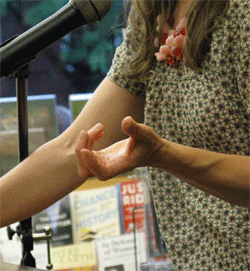 As for her aesthetic approach to blog, book and video, she acknowledges that looks can be deceiving. “Yes, it looks very easy, but it’s not. Sometimes a single image takes five minutes, sometimes two or three hours. I put a lot of time into it and I have to be very organized.”
As for her aesthetic approach to blog, book and video, she acknowledges that looks can be deceiving. “Yes, it looks very easy, but it’s not. Sometimes a single image takes five minutes, sometimes two or three hours. I put a lot of time into it and I have to be very organized.”
There’s much to consider in addition to the food: light, fabrics, props, plates. “It may look incidental,” she says of the final result, “but it’s not.”
Tartines, the namesake of her blog and book, are akin to an open-faced sandwich with various toppings. The French traditionally eat tartines for breakfast at home, with butter and jam, although any sweet spread will do. In general, her nation much prefers lunch to breakfast, which generally gets short shrift there. “Growing up, nobody skips lunch, and everyone talks about food,” she recalls.
The thin slices of bread in a tartine can support any sort of topping, leading Béa to experiment with many variations. Marinated fennel with radishes; broiled eggplant and baked tomatoes; and Spanish piquillo pepper and avocado – the last two combos atop ricotta cheese.
“I am a real ‘tartine’ girl,” Béa writes, recalling the tartines her mother prepared for her growing up. “There is a whole world attached to mes tartines. I cannot explain it.”
A typical day of meals for her still sounds like something out of Saveur: Fresh apple juice, fresh muesli with fruits and nuts in the morning, with green tea and toast – “I love to spread avocado and feta on top.” At lunch, a vegetable tart with salad and soup, a chocolate cake, and a fruit tart or clafoutis. A risotto with seafood and baked apricots with coconut milk and lime juice for dinner.
 Clearly, hers is a kitchen where fruit tarts, not Pop-Tarts, hold sway. (Has someone told her about the Joylicious™ world of flavor and fun she’s missing out on?) An audience question about scrapple – that Pennsylvania Dutch dish of pork scraps, cornmeal and flour – left her confounded. And she acknowledges that England was the first place she encountered eggs and granola for breakfast.
Clearly, hers is a kitchen where fruit tarts, not Pop-Tarts, hold sway. (Has someone told her about the Joylicious™ world of flavor and fun she’s missing out on?) An audience question about scrapple – that Pennsylvania Dutch dish of pork scraps, cornmeal and flour – left her confounded. And she acknowledges that England was the first place she encountered eggs and granola for breakfast.
She’s already at work on the concept for her next book. Feeding her blog and business, as well as her husband and daughter, will keep her hands full, as well. One comes away wondering why our life cannot more often resemble the life of La Tartine Gourmande; a life (to paraphrase Béa) of semi-sweet memories and stories wrapped around recipes.


